




Ragnar Wesstrom has conquered the unchartered waters of Great Slave Lake to build a fishing lodge on Enodah island in the Northwest Territories. Swedish Press visited his wilderness retreat Trout Rock Lodge, home to the world’s biggest northern pikes.
By Kajsa Norman
Look for B-boy, he should be on the same flight.”
“What does B-boy look like?”
“Maybe Trout Rock Lodge hat? Skinny.”
I’ve texted Ragnar to let him know I’ve landed in Yellowknife and now I’m not sure what to do. The plane is full of skinny guys wearing ball caps. If only he had a normal name. I’m reluctant to shout: “B-boy? B-boy?”
I resolve to wait near the exit. Some 20 minutes later, a man bolts in and hollers
“Kajsa! Kajsa Norman!”
“That’s me!”
“Welcome to Yellowknife. We’re late!” He turns arounds and exits back the way he came. I follow. I can only assume he is Ragnar Wesstrom, the man I am here to meet. I get in the back of his truck. A tall, skinny guy wearing a ball cap is sitting in the front seat. B-boy, I presume. Next to him, a tiny, white dog which barks incessantly.
“Shut up, Kulan,” Ragnar shouts and turns to me. “So, you couldn’t find B-boy, eh? I thought you were supposed to be an investigative journalist.”
I smile. Ragnar is the kind of man one rarely meets in metropolitan Sweden or Canada anymore. Rude, direct, brutally honest, and very rough around the edges, but with a good heart and the ability to survive anywhere. Exactly the kind of

companion one would want when heading into the northern wilderness. We drive to Yellowknife’s Old Town where a Beaver floatplane is waiting at the quiet dock on the northern coast of Great Slave Lake. B-boy – whose real name turns out to be Chris – is meant to take the 12-minute flight to Trout Rock Lodge to join the rest of Ragnar’s crew. Waiting on the dock is the lodge’s manager Jake, the fishing guide Zander, and Andrea (or Bonita as Ragnar calls her), the beautiful chef from Costa Rica. We all shake hands and join forces to load the bags onto the small floatplane. The old, red Beaver sputters and coughs.
“It’s from 1957. As old as me,”
Ragnar laughs.
After a series of false starts, I begin to wonder if we’ll have to spin the propeller by hand, but the engine finally catches. We wave them off and get back in the truck to go pick up supplies. As we reach the grocery store, there’s a massive downpour. While we wait it out, Ragnar tells me the story of how he ended up here, on the edge of civilization.
Born in 1957, in Rotebro some 20 km north of Stockholm, Ragnar’s brother and uncle were merchant marines, and he grew up knowing he, too, wanted to be a sailor. In the early 70s, at the mere age of 16, he signed on as a merchant marine with Gränges
Shipping, one of the most reputable companies in Scandinavia at the time.
“I was a grease monkey, working down in the engine room,” he says.
His first contract lasted 13 months, and he signed on in Antwerp, Belgium.
“I was lucky,” Ragnar recalls. “We went around the world, and I got to see the United States, the Panama Canal, Japan, the Philippines, and Singapore. We ended in Marseille where I signed off. It was very good times, but also a great way to grow up and learn about work and responsibility.”
Ragnar would spend the next five years working in the engine rooms of super tankers in South America. Life consisted of hard work onboard and wild parties ashore. When he wasn’t working or drinking, Ragnar spent his free time in the ship’s library reading anything he could find about the far north. Among his favorites were works by the British-Canadian poet Robert Service, known as “the Bard of the Yukon” for his many poems set in northern Canada, and Jack London’s The Call of the Wild
“In one of the books there was a handwritten map of Great Slave Lake and Great Bear Lake in the Northwest Territories,” Ragnar recalls.
Just like London’s protagonist Buck, Ragnar felt he was destined to one day go north to test himself against the elements of the wild.
In 1986, Ragnar set out on a yearlong trip around the world with his best friend. They ended their travels in Edmonton and when the friend returned to Sweden, Ragnar decided to keep heading north on an unpaved road, heeding that call of the wild he had always sensed.
On June 19, 1987, after 17 hours of hot and dusty driving straight north from Edmonton, Ragnar arrived
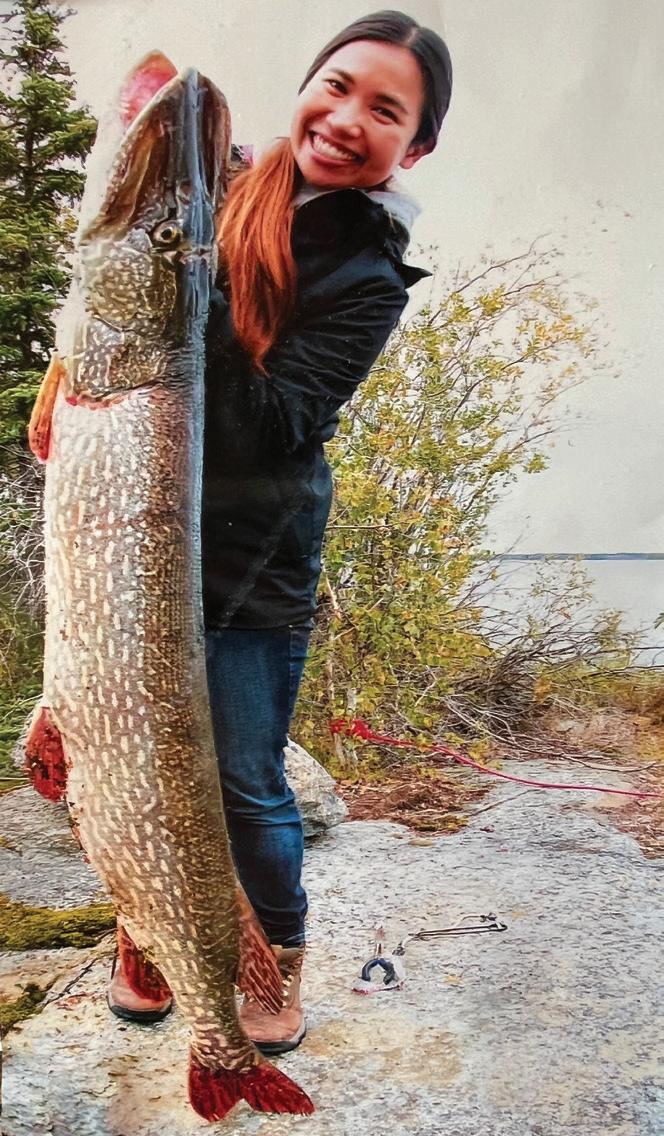
A guest with an impressive catch. Photo: Private
in Yellowknife in the Northwest Territories.
“Here was this city in the middle of nowhere. There were hotels, restaurants, and bars and I thought, wow, this is awesome,” Ragnar recalls.
The city of Yellowknife was founded as a gold mining community in the 1930s and the discovery of additional mineral and diamond deposits over the years led to slow but continuous growth. The pace of development spurred the need for both hydro power projects and the construction of a northern highway. The commercial extraction of lead and zinc at Pine Point brought a railway to Great Slave Lake in 1964. In 1991, diamonds were discovered at Lac de Gras and in 1998 the first North American diamond mine went into operation 300 kilometers north of Yellowknife. Today, about 20,000 people call Yellowknife home.
While diamonds had not yet been discovered when Ragnar first set foot in Yellowknife in 1987, the town was already hopping. Ragnar found himself a hotel and took a muchneeded shower. It was Midsummer’s Eve, so he cracked a beer and went down to the lobby to ask where the best place to party was.
“RJ Bar. Right upstairs,” replied the receptionist.
The place was completely packed. Ragnar walked through but couldn’t find a seat. Figuring there must be other places, he headed for the door. However, just before leaving, he glanced to his left.
“There were three Indian girls and four seats, so I walked up and asked if I could sit down. They said, ‘yeah,’ and that’s how I met my wife. My first night in Yellowknife! She looked like an Apache girl from the Western movies,” Ragnar recalls.
The following year, in 1988, Ragnar and Doreen were married.
*
Having seen the others off on the floatplane, Ragnar and I load the rest of the supplies onto his boat and puttered out of the Old Town marina past the houseboat community. Some 30 houseboats which look like tiny houses on metal or plastic pontoons make up a colorful floating neighborhood. It dates back to the 1980s when frustrated residents wanted to escape ever-rising real estate prices and an ever-expanding net of city regulations. In the spirit of defiance which seems to characterize the far north, they built floating homes and moored them next to Jolliffe Island where they would be both shielded from the wind and technically off municipal lands.
“The local government have tried
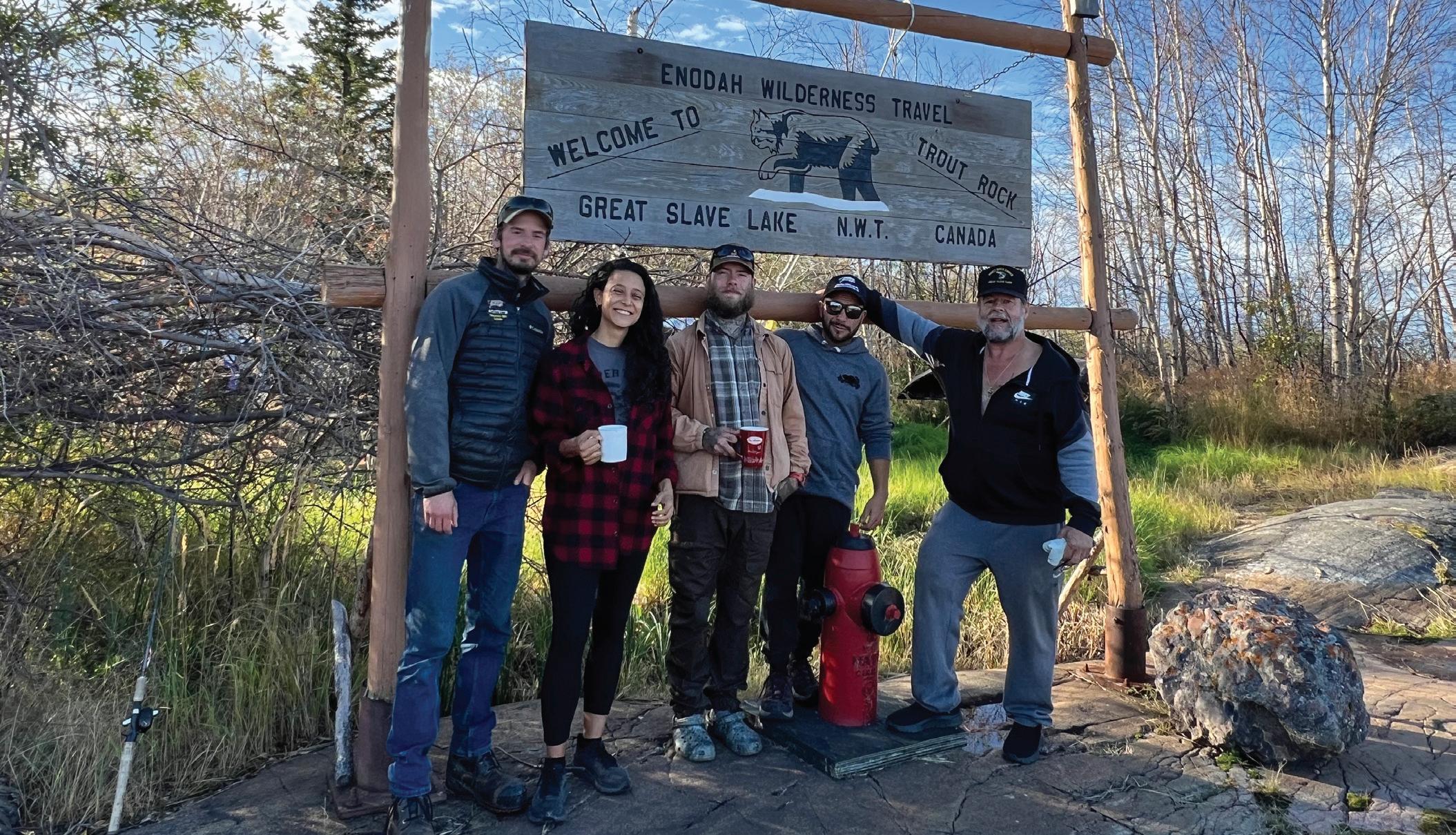
to sue them for refusing to pay tax, but the houseboaters won. They are not considered residents of Yellowknife,” says Ragnar, as we leave the sheltered bay behind and set course for the lodge.
The Canadian Shield, scraped flat by the last ice age, defines the natural landscape. Dotted with thousands of rocks and tiny, tree-covered islands, the vista feels oddly familiar. This could be the Swedish or Finnish archipelago. Great Slave Lake is the ninth largest lake in the world. At 480 kilometers (300 miles) long, in a boat, it feels like an ocean. The route to Trout Rock Lodge goes through uncharted waters, and Ragnar claims to be the only white man who knows how to navigate them. His wife Doreen and her parents taught him the way back in the 80s.
Doreen is Dogrib, a Dene First
Nations people. She was born in 1954 on Trout Rock Island, or Enodah island as it is called in her native tongue Dogrib. Many people living around Great Slave Lake, trace their ancestry to the T'satsaot'ine, or “Copper People”, who were known for the tools they made from raw copper. Fur traders who travelled these parts in the late 1700s called the locals “Yellowknives” because of the copper handled knives they crafted. The name stuck. In 2015, the Yellowknives Dene First Nation’s membership was 1,489 people.
Enodah means “many lynx”, an indication of the wild state of the surroundings. At the time of Doreen’s birth, the island was home to over 60 families, living in dugouts. There was a Protestant Sunday school operated by German Father Zimmerman and his wife, as well as a small Catholic
church. For a few years, in the 1930s, there was even a Hudson Bay trading post.
In the mid-1950s, the government supplied families in the community with 20’x18’ log cabin kits. But there were also more sinister ways of attempting to civilize the locals. Representatives of the Catholic church and the RCMP would arrive by floatplane or dog teams to forcibly collect all the children and take them to residential school in Fort Resolution. Doreen spent seven grades at residential school.
“They weren’t allowed to speak their language or practice their traditional religion. They were abused. It was hell. She hated it and doesn’t like to talk about it,” Ragnar says.
Finally, Doreen’s parents decided to hide her and her sister in the bush, claiming not to know their
whereabout when representatives of the Catholic church and the RCMP came to pick them up.
In the early 60s, the government decided to build a winter road to the community without consulting the people living there. When they started to brake trail, locals figured road access to Enodah would completely alter their lifestyle. If they were going to be forced to integrate with the outside world, they might as well move to Yellowknife or other bigger communities. Consequently, most families left. With the island now practically abandoned, the construction of the road was discontinued.
Only Doreen’s family stayed on Enodah island until 1974. They lived exclusively off the land, hunting, fishing, and trapping. Doreen’s parents dismantled most of the abandoned cabins and used them for firewood. Living alone in the wilderness was difficult as they were entirely at the mercy of the elements of this cold and hostile environment. Out of 12 siblings only Doreen and her sister survived. Some starved to death, others drowned or froze.
Ragnar first visited Enodah island in 1987, shortly after his arrival in Yellowknife. He went out with Doreen and her parents to the tiny cabin where they used to live.
“There was nothing there,” Ragnar recalls. Nothing but massive northern pikes, that is. As a hunter and fisherman, Ragnar immediately saw the potential. He and Doreen secured a federal lease for the land and in 1989 they built the first tent frame for visitors from the American trophy fishing community.
“But it wasn’t easy. It took probably 10-12 years before we were
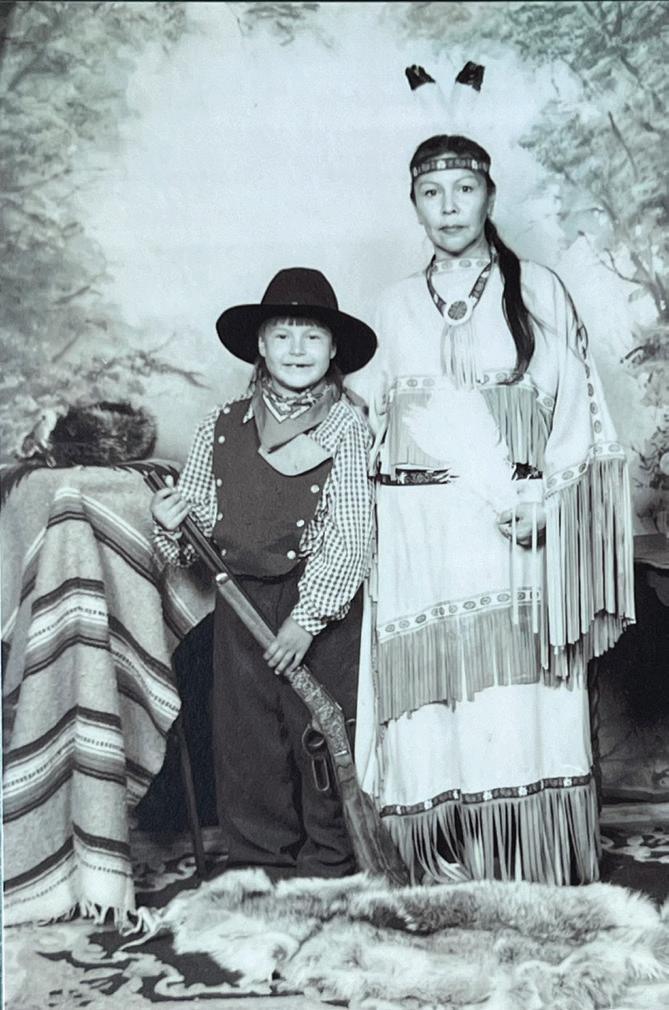
making any money,” says Ragnar.
The first year they could only accommodate 4 people. The following year they built enough tent frames to accommodate 8 people. Then followed a cabin each year until they reached their current capacity of 16 guests in heated cabins with electricity and hot water. Now there’s even Wifi, but the original cabin where Doreen and her family used to live still stands at the heart of the small resort.
Great Slave Lake is the deepest lake in North America at 614 m (2,014 ft), but in the North Arm of the lake where we are travelling, it is shallow with innumerable rocky shoals. It makes for treacherous boating.
Consequently, most people avoid this part of the lake, leaving Ragnar with no competition. His Trout Rock Lodge is the only trace of civilization in the 100 miles long North Arm.
“It’s a minefield,” says Ragnar, as he is forced to slow down to avoid the boulders hidden just below the
surface.
To make matters worse, the water levels are unusually low this year so a boat ride which normally takes 50 minutes will now take us a couple of hours.
We weave back and forth to avoid the rocks and shoals. Like something out of Top Gun, but by boat instead of air. Then, at 17:30 sharp, Ragnar suddenly brings the boat to a complete halt.
“Five thirty, it’s beer o’clock,” he exclaims, and cracks open a Molson Canadian.
“Vill Fröken ha en öl?”
He throws me a can and we proceed while chatting away. Minutes later, the beer explodes on my lap as one of the many treacherous reefs hiding just beneath the surface has graced the engine.
“F*ck, and we’re almost there,” shouts Ragnar. He knows engines, he can hear it’s been damaged. We putter the remaining distance to the lodge.
Approaching from the water, Trout Rock Lodge looks like a haven in the wilderness. It consists of a few red cabins, a couple of tipis and an inviting main lodge facing the waterfront. Inside the main lodge, the walls are decorated with various trophies: mounted bear hides, lynx and pike. There are also a number of world record certificates issued by the International Game Fish Association to Ragnar’s clients for different line categories of northern pike. While the certificates are impressive, the pictures are jaw-dropping; Ragnar and his guides and clients posing with their catch of trophy pikes, some nearly as big as the people holding them.
The biggest pike Ragnar has ever caught on a fly rod was 53 inches long.
“That was pretty memorable,” he
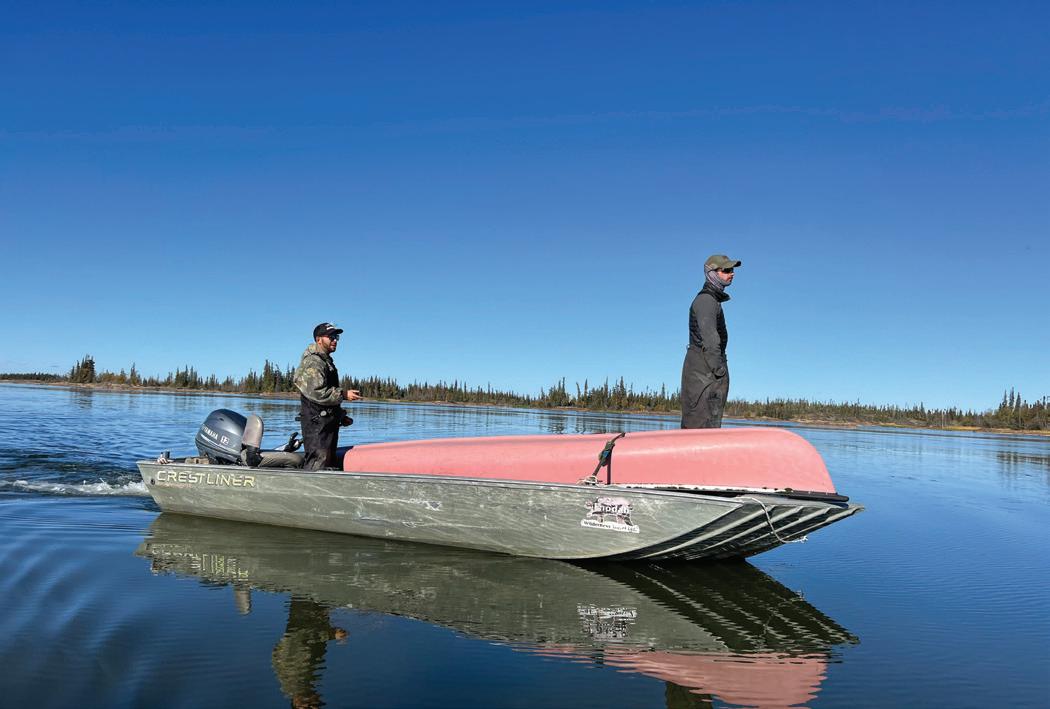

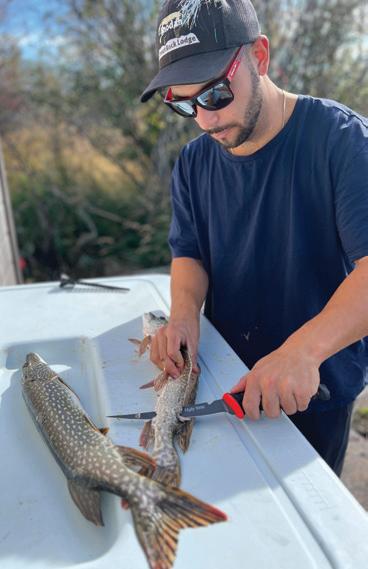
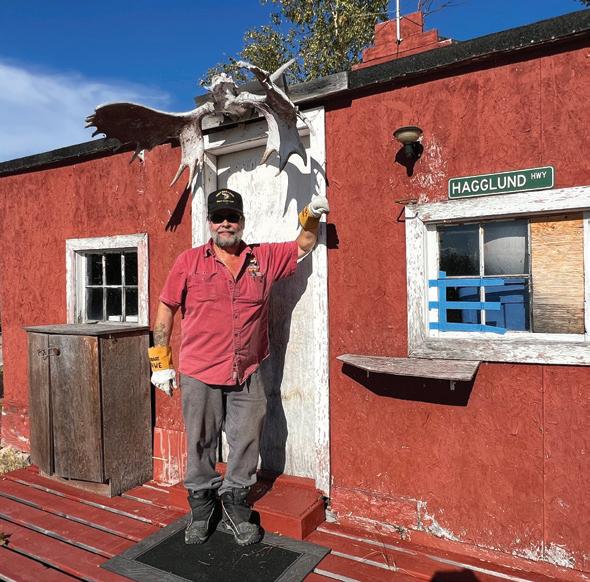


laughs. However, these days Ragnar no longer does much fishing. It’s all about his clients and helping them find and catch the fish of a lifetime.
“The biggest one we’ve caught here at the lodge was 56 inches long,” says Ragnar.
The lake is also home to Burbot, sometimes known as freshwater cod or lingcod. “It’s tasty so people call it poor man’s lobster,” says Ragnar. But it’s the northern pike that is the lodge’s claim to fame.
Ragnar sometimes hires Swedish seasonal fishing guides and kitchen staff for the peak season, which runs late May to early July when the pike spawn. Then there’s one fishing guide and one boat for every two clients and
it’s virtually impossible not to catch a massive pike.
In the evenings, the trophy fishermen, many of them repeat clients, tend to congregate in the lodge’s fully licensed bar to exchange fishing tales. Ragnar enjoys hosting. He serves delicious cocktails, while sharing one crazy story after another.
There was a time when Ragnar didn’t drink. In 2010, he was diagnosed with Type 2 diabetes and decided to clean up his act. In Yellowknife, his transformation was big news. Up here business, “the magazine of Canada’s enterprising north,” dedicated two full spreads to Ragnar’s new life under the headline “A wild man gets civilized”.
“What in the name of all that is holy has happened to Ragnar Wesstrom? After all, we’re talking about a guy who, sulking over a night of drunken poker gone wrong, once cut off the lodge’s power supply in a failed bid to get his guests back to the gambling table,” read the article. Ragnar cut out alcohol and sugar, began to eat vegetables and exercise. He shed 50 pounds in a year and while his body was probably better off, his soul was not.
“It was the most boring year of my life,” Ragnar exclaims. He finally went to Vegas on an epic bender to reclaim his old ways and returned home with a new tattoo to add to his collection of sailor’s markings. Right
on his chest where most sailors carry a heart and the name of their true love, or their mother, Ragnar had imprinted “BV206”. BV is short for bandvagn, (Swedish for bandwagon) and BV206 is the brand of Ragnar’s Swedishmade Hägglunds, military grade bandwagons, or a tank-like ATV if you will, with six-foot-wide tracks and an ability to travel over and through practically anything.
“I love them! I’m a häggoholic,” he exclaims.
While they are certainly fun to ride, for Ragnar the exotic machines have also transformed his business from struggling to successful, enabling him to also cater to visitors in search of the aurora borealis.
In the Northwest Territories, the northern lights are visible for up to 240 nights per year, in other words nearly every night from late summer to early spring, thanks to the low humity and mostly clear skies.
Situated directly beneath the Auroral Oval, a concentrated area for the most intense Northern Lights activity anywhere on Earth, Enodah island is one of the best places in the world to experience the northern lights. Since it’s so remote, there are no lights of civilization to distract from nature’s light show.
It’s close to 11 pm when I step out of the lodge to make my way to my cabin.
The autumn sky is already lit up by intense turquoise and slightly pink swirls of light, they perform a mesmerizing dance above me. It’s late August and not yet cold, so I lie down on the ground to enjoy the show.
The sky is clear and speckled with countless stars. The Dene recognize a constellation of stars called Yidha, described by elders as the spirit of the
legendary hero Yamórıa who, after making the world safe for humans, watches over us from the sky. The Milky Way is his trail that circles the world, the Big Dipper is his cooking pot and all the unnamed stars around him tell the stories of what he did on earth.
The Dene believe the Aurora originate in his fire and that the lights linger in the sky as a reminder that the creator is still watching over us.
The next morning, I wake up early and head down to the dock.

I’m no fisherman, but I pick up a fly rod from one of the boats and cast it. Minutes later I reel in my first ever pike. It’s only about half a meter, or 20 inches long, which means I’m allowed to eat it (anything above 40 inches is catch and release). Northern pike have an abundance of bones, so they are notoriously difficult to fillet, but Zander and Chris help me out. Andrea turns the white, flaky pike meat into a delicious breakfast.
At 9 am, a newer version of the Beaver floatplane comes to transport me and a set of Ragnar’s beloved bandwagon tracks back to civilization. The crew struggle to get them through the tiny door of the floatplane but with grit and joint effort they finally manage, slightly damaging the freshly
painted floatplane in the process
When we arrive in Yellowknife, the owner of the floatplane is not happy about the scratch.
“I told him it couldn’t be done, but Ragnar wouldn’t listen,” he shouts at me.
“He never f*cking listens, you can write that in your magazine!”
Well, Ragnar was right. It could be done. The tracks did fit. How else could we be unloading them now? I think to myself while nodding compassionately at the upset man. It just comes down to determination. When chasing your dreams in the wilderness, you can’t be afraid of a few scratches.
Visit https://enodah.com/ to learn more about Trout Rock Lodge and tours.
Hope you enjoyed this sample of Swedish Press.
To read more, please click the link https://swedishpress.com/ subscription to subscribe.